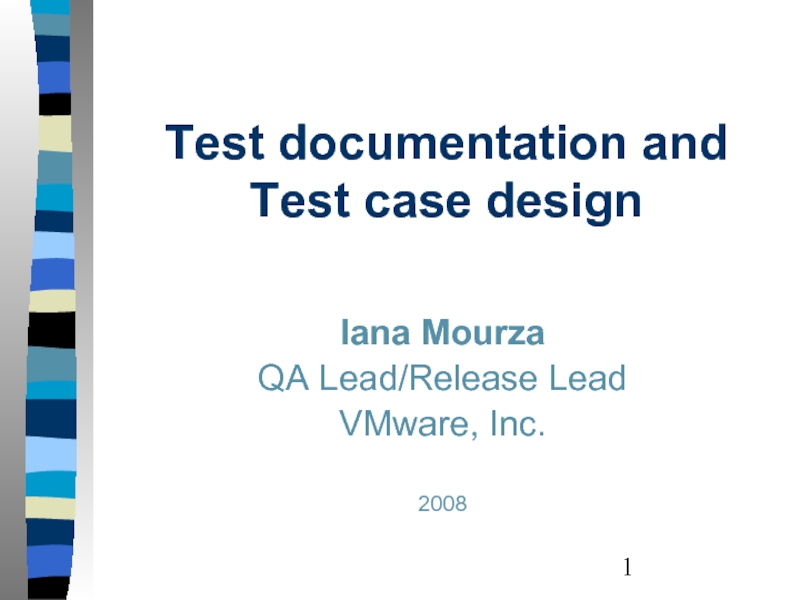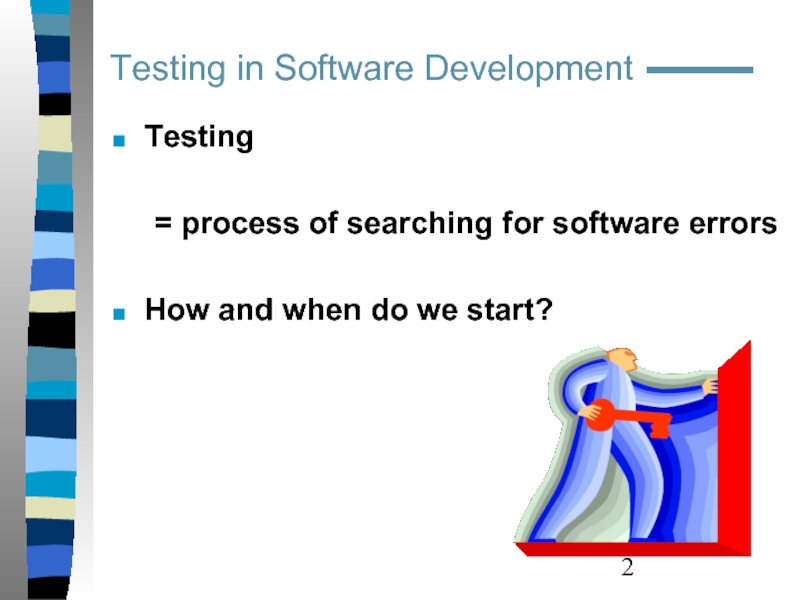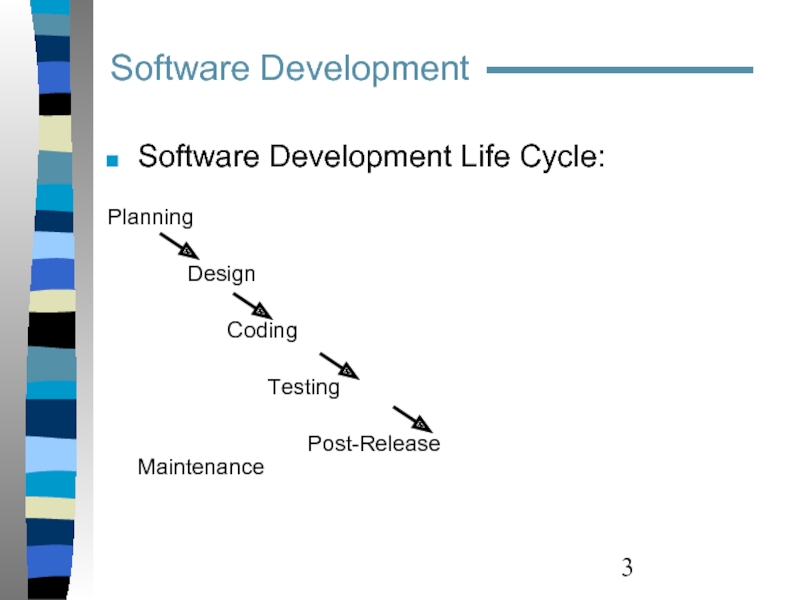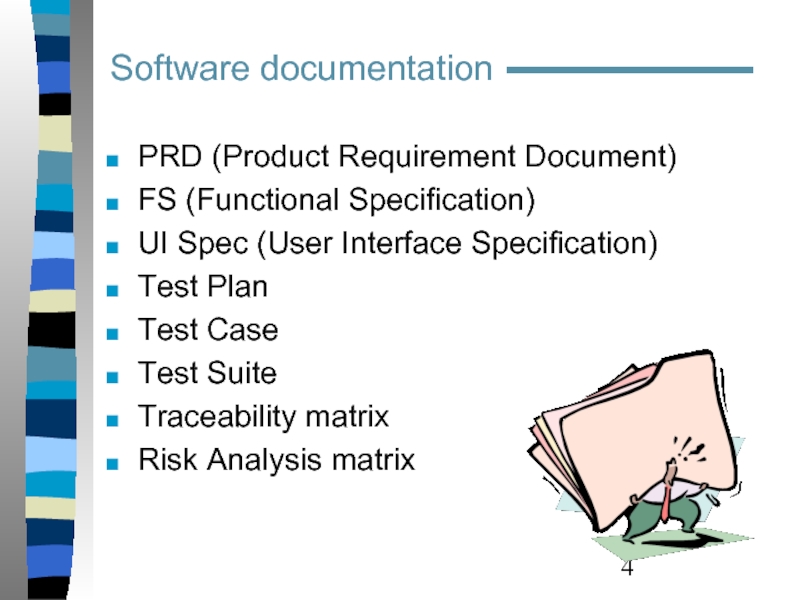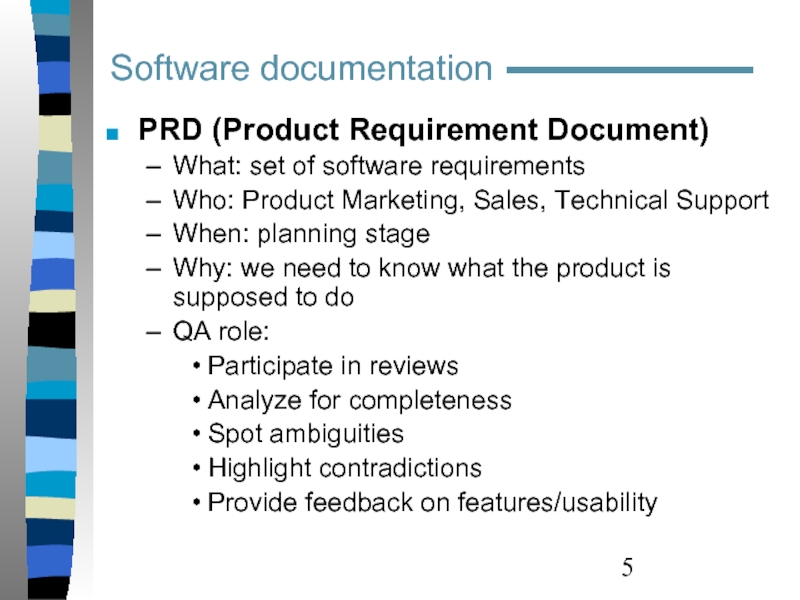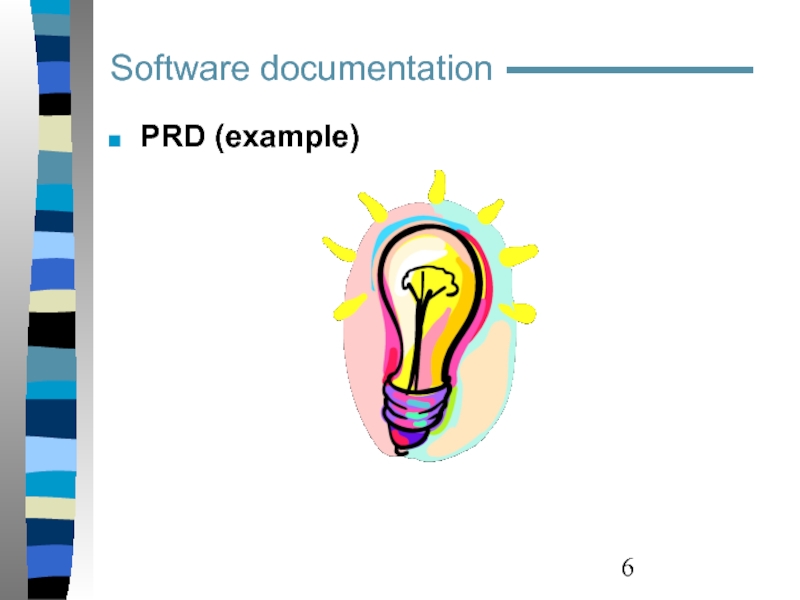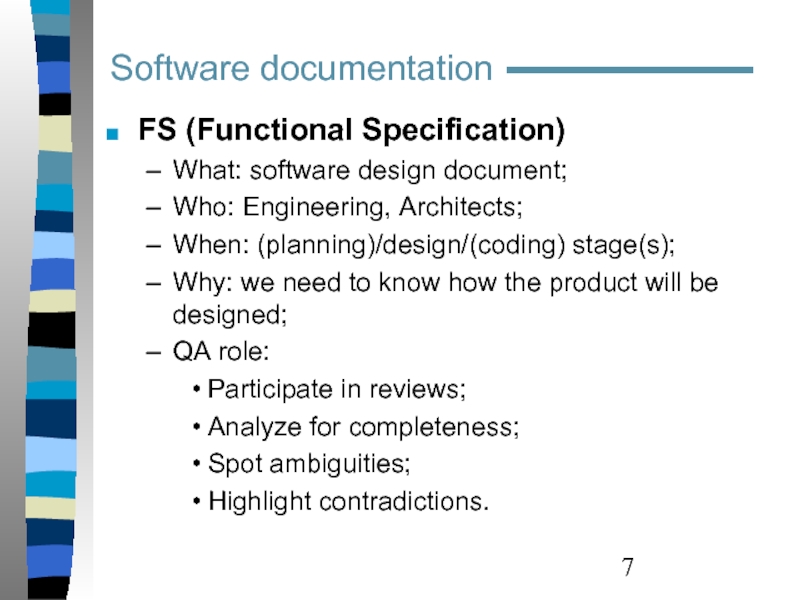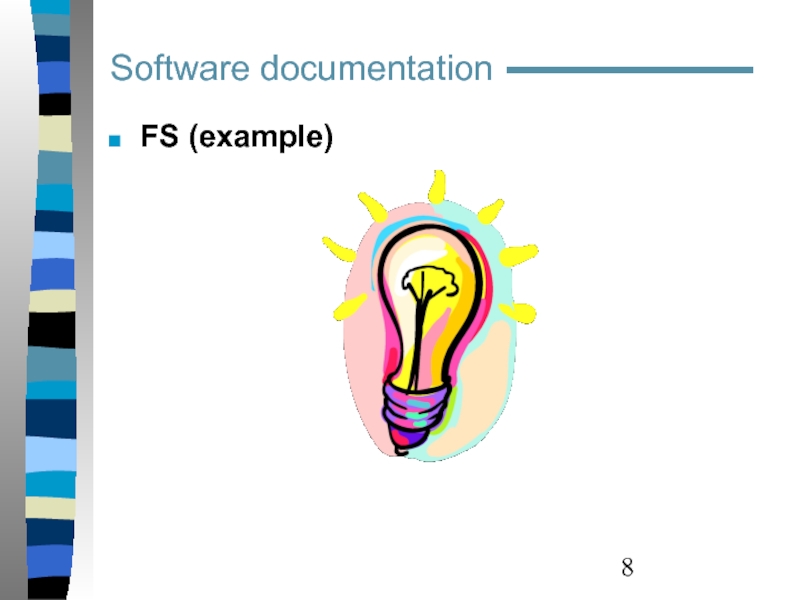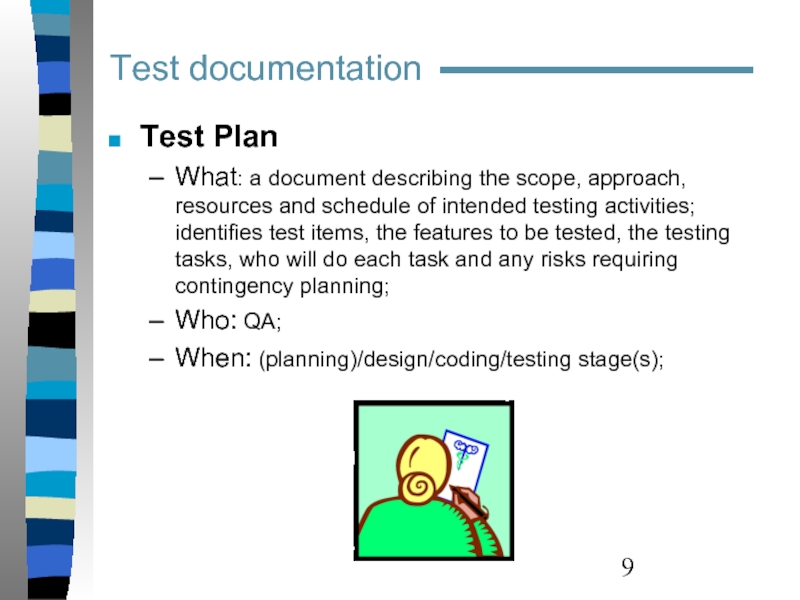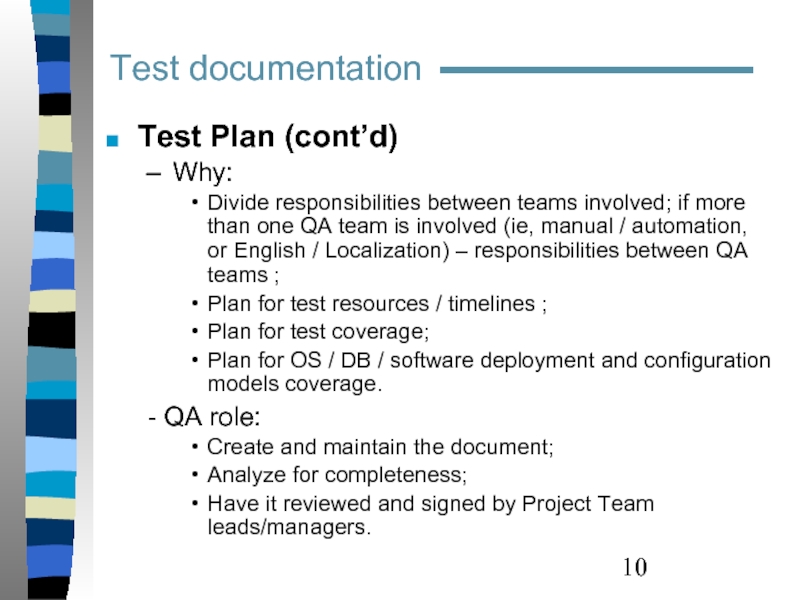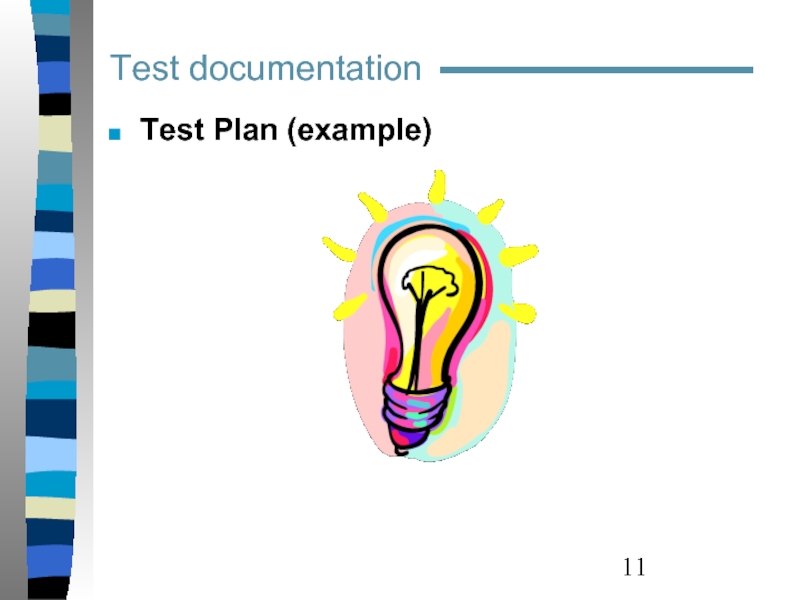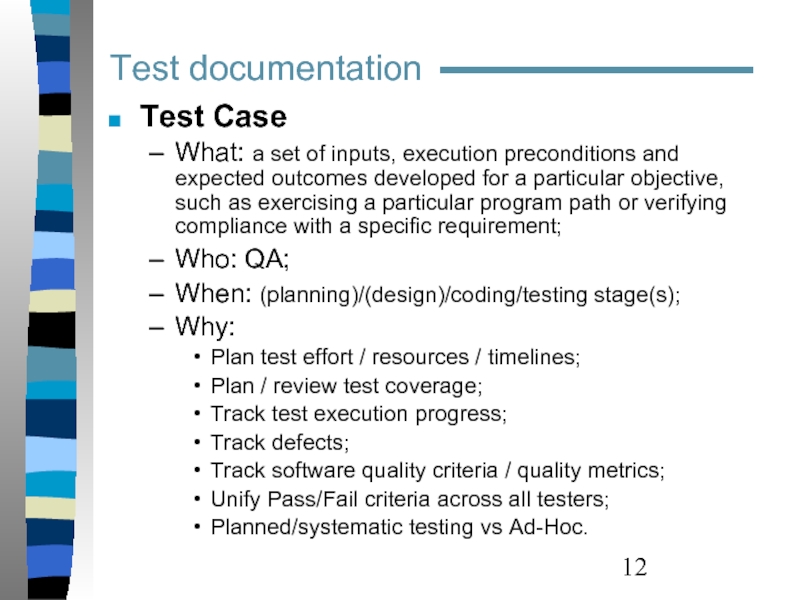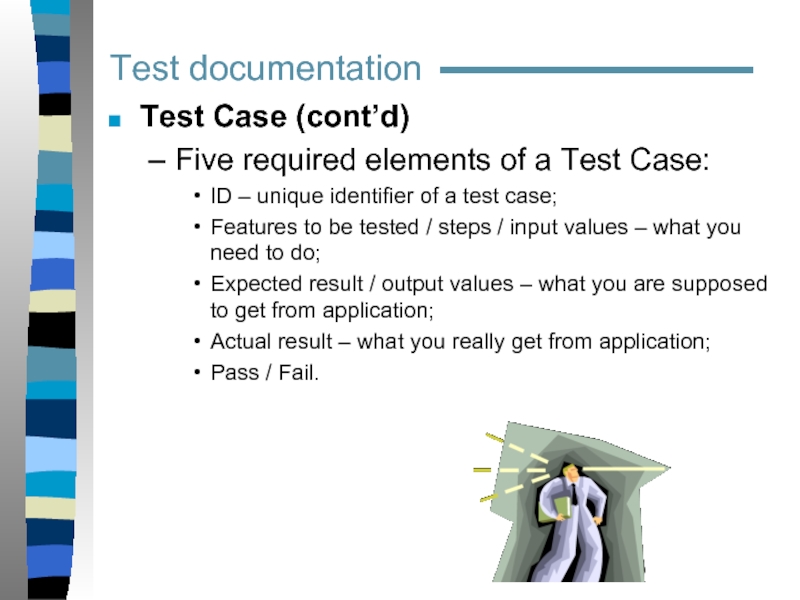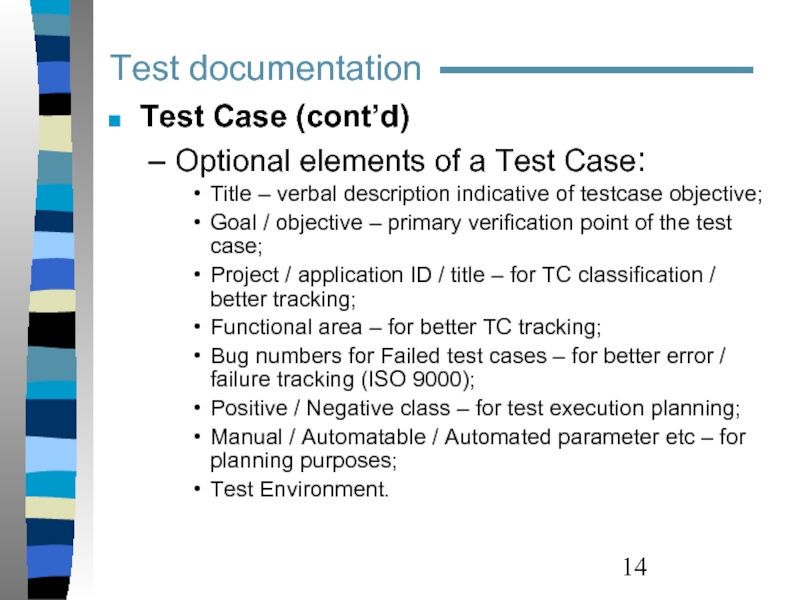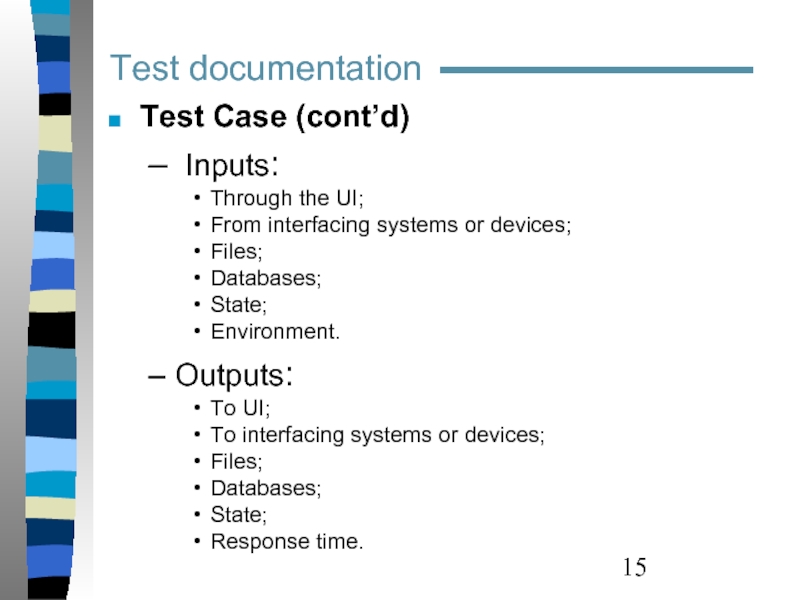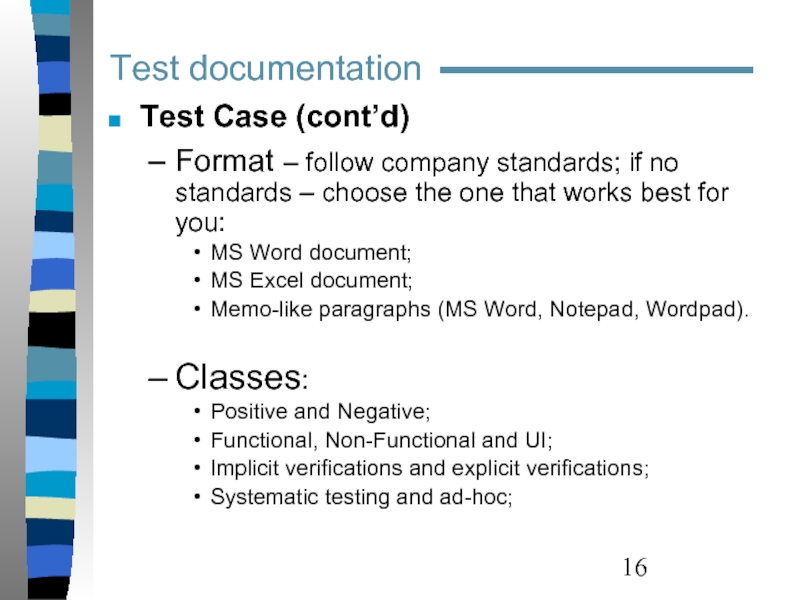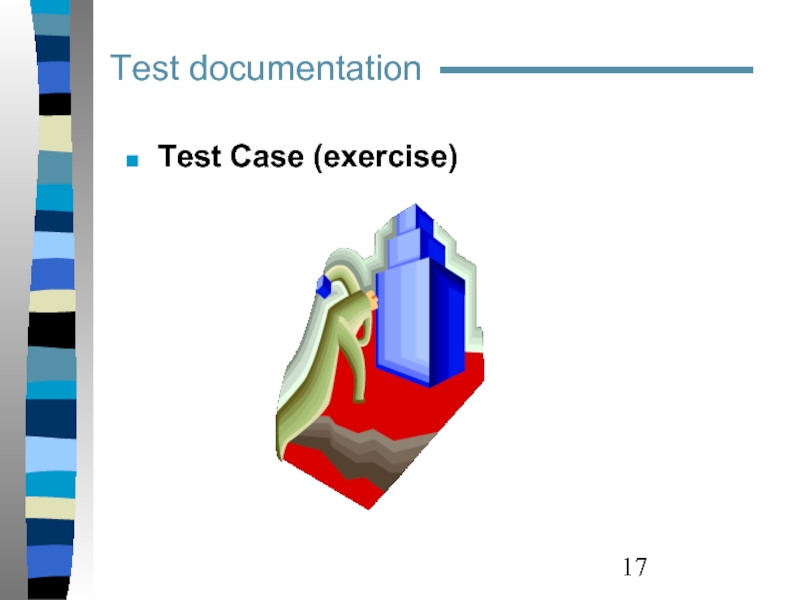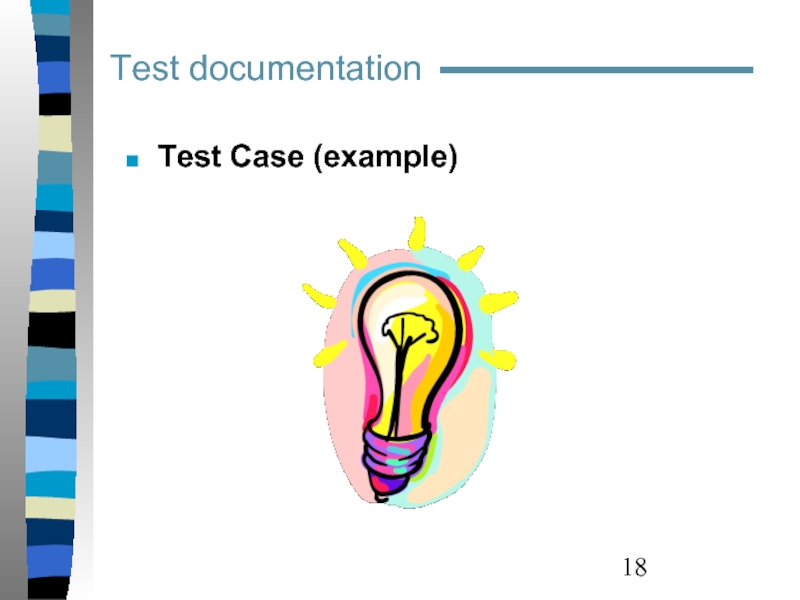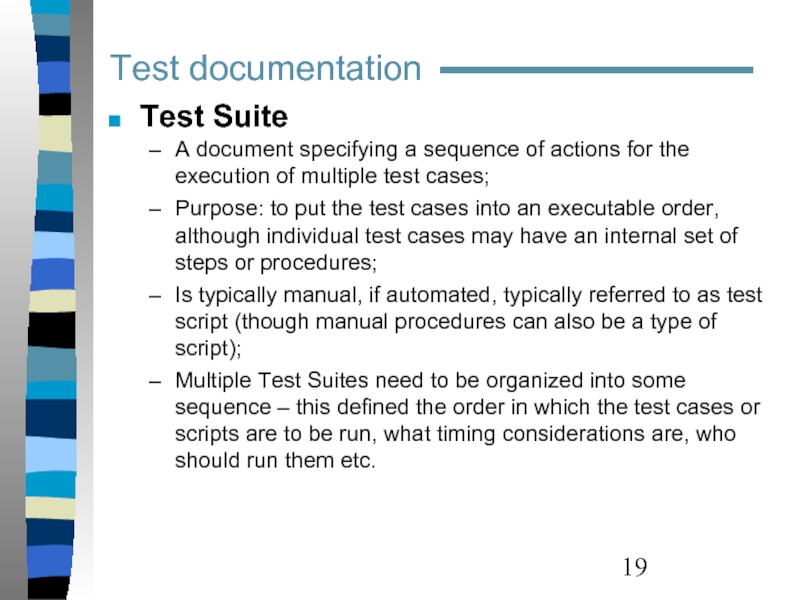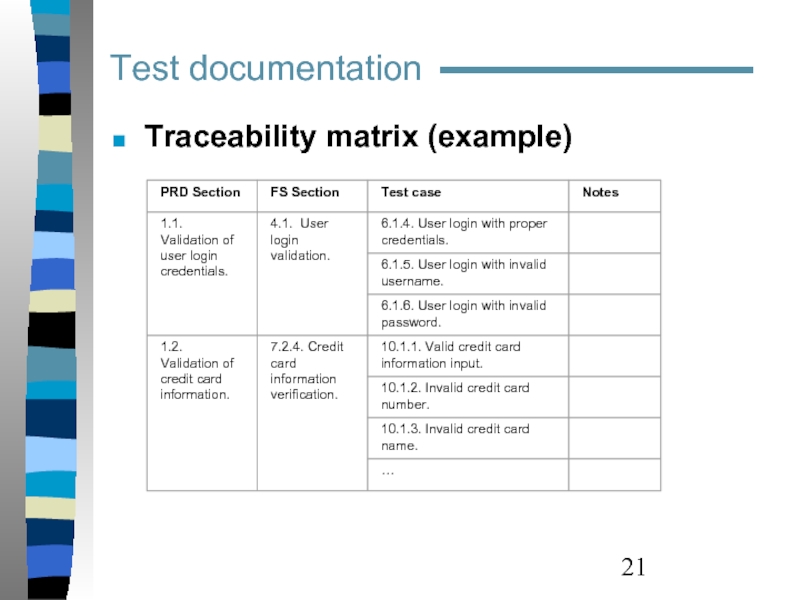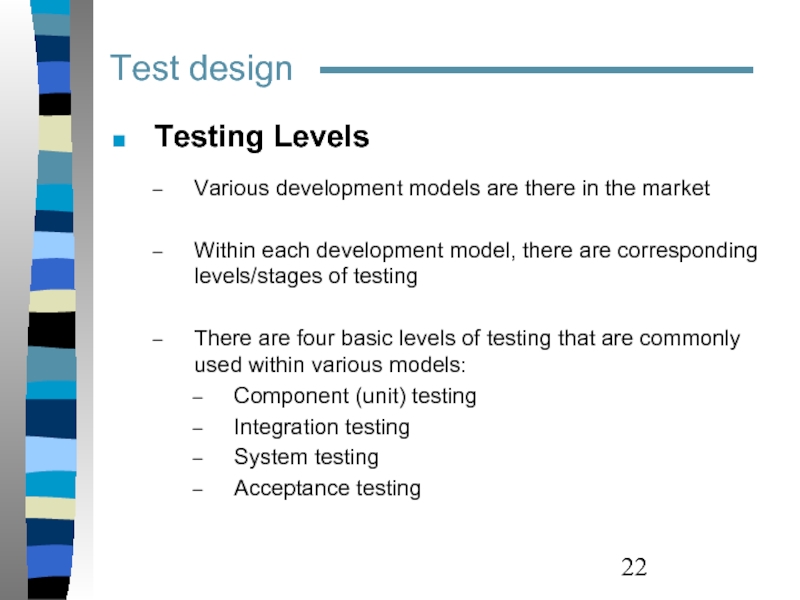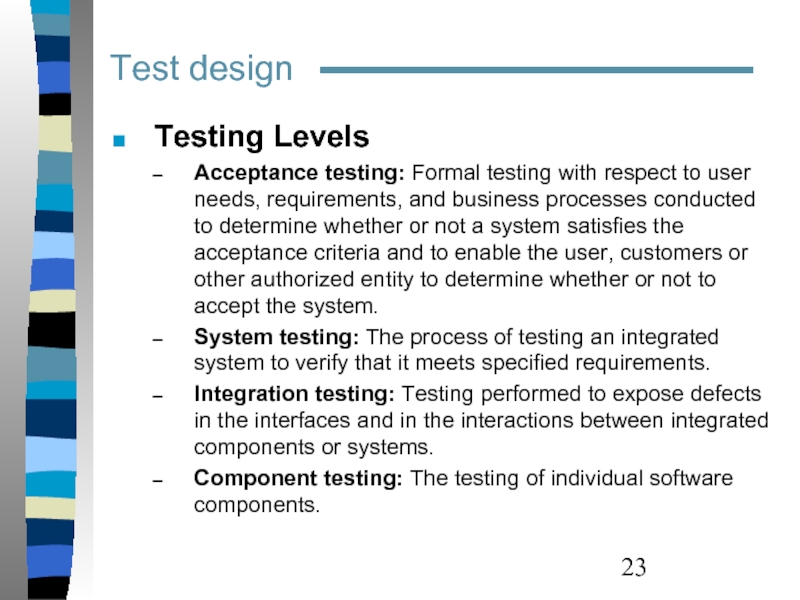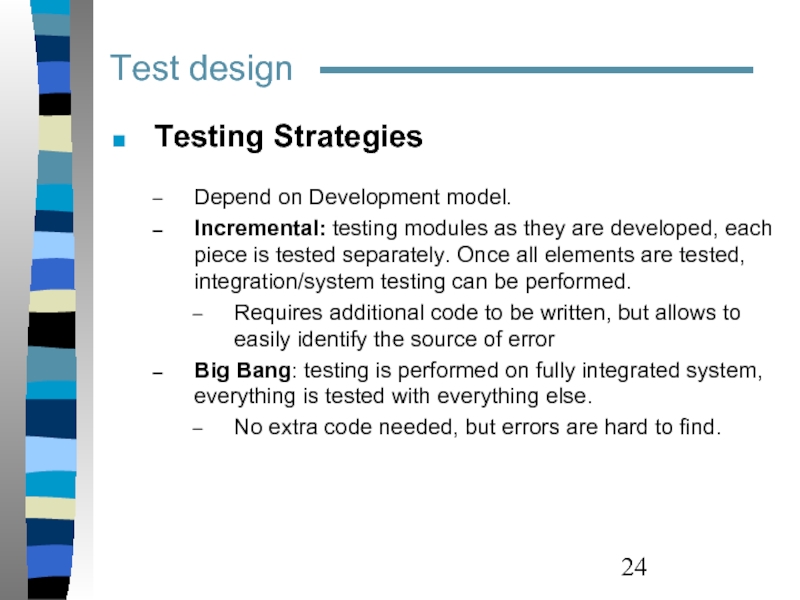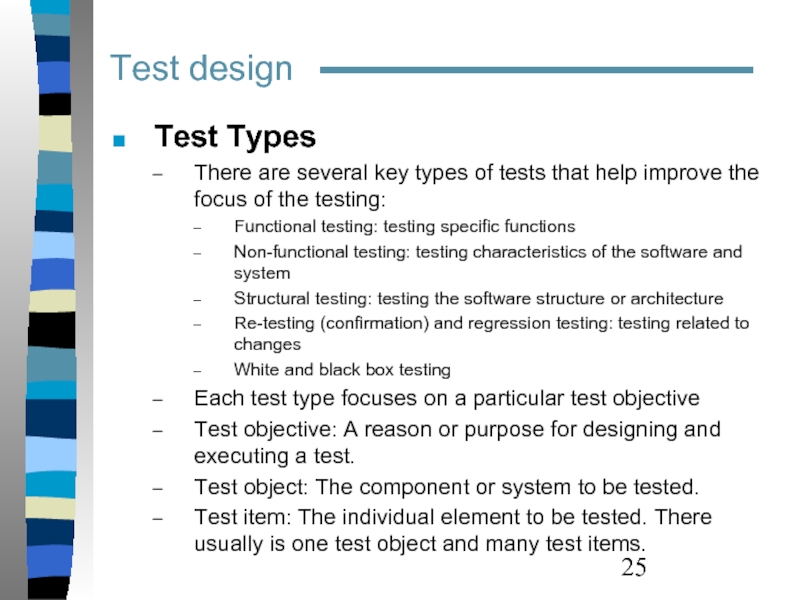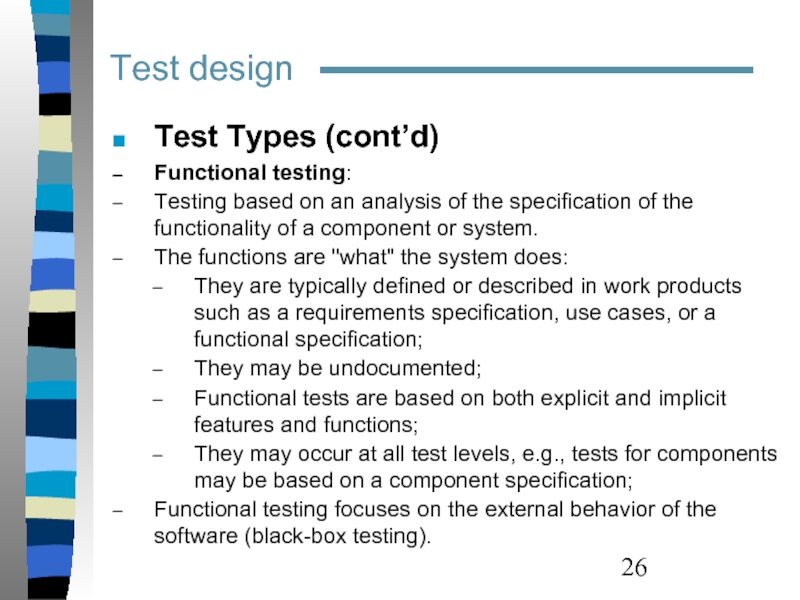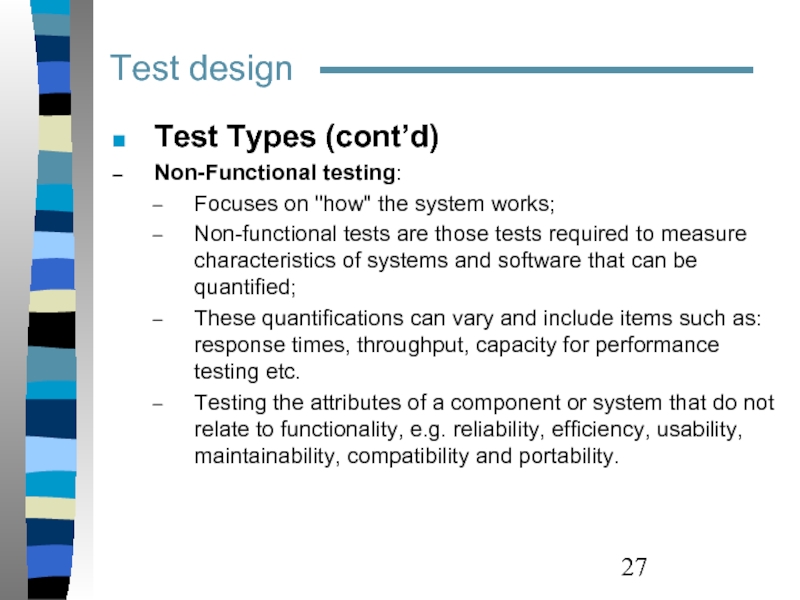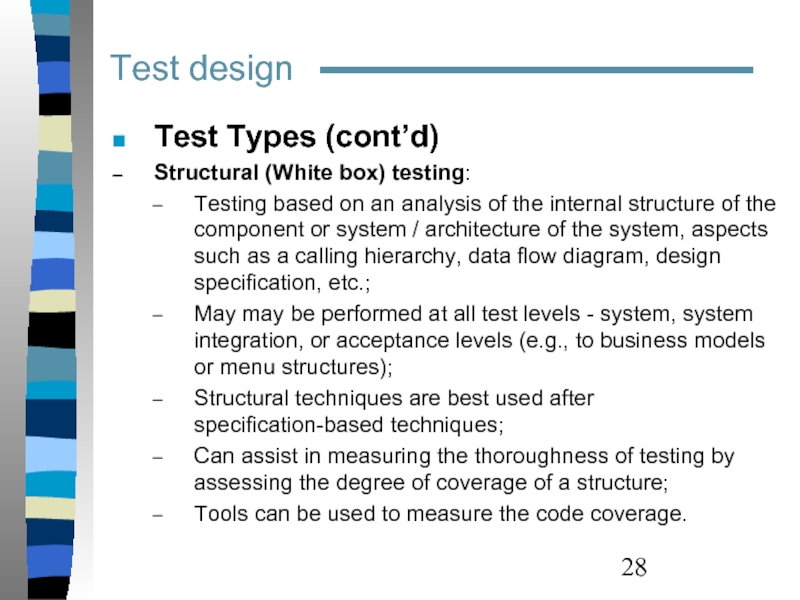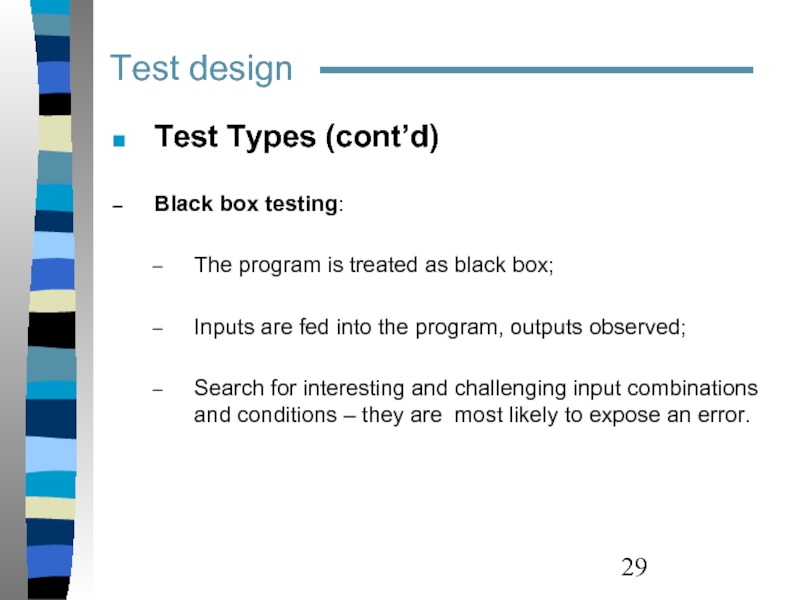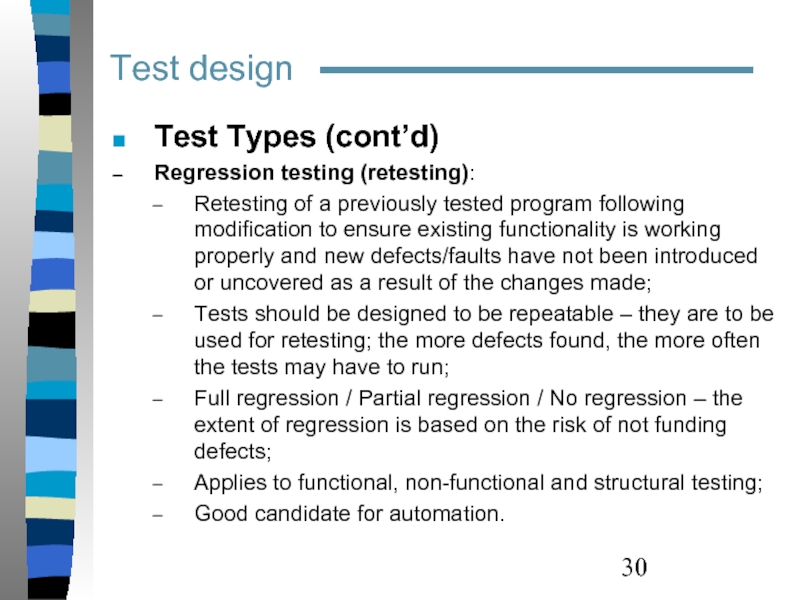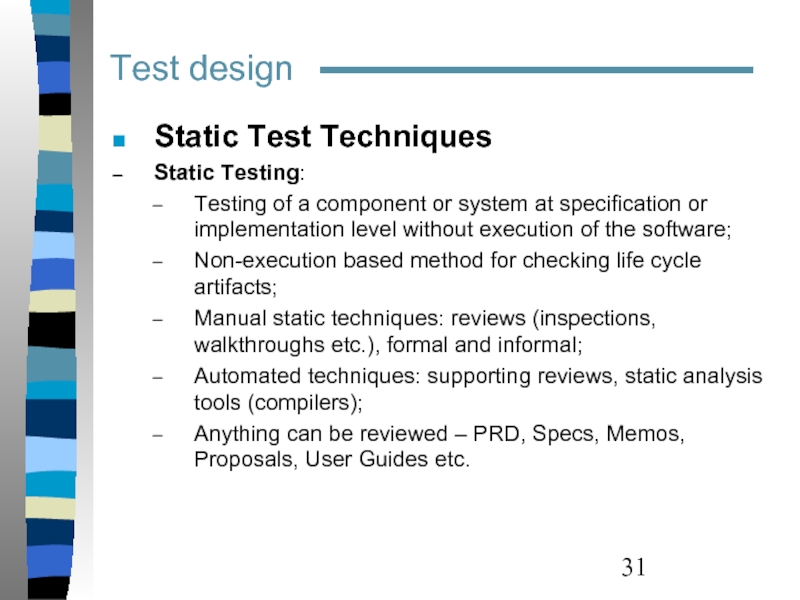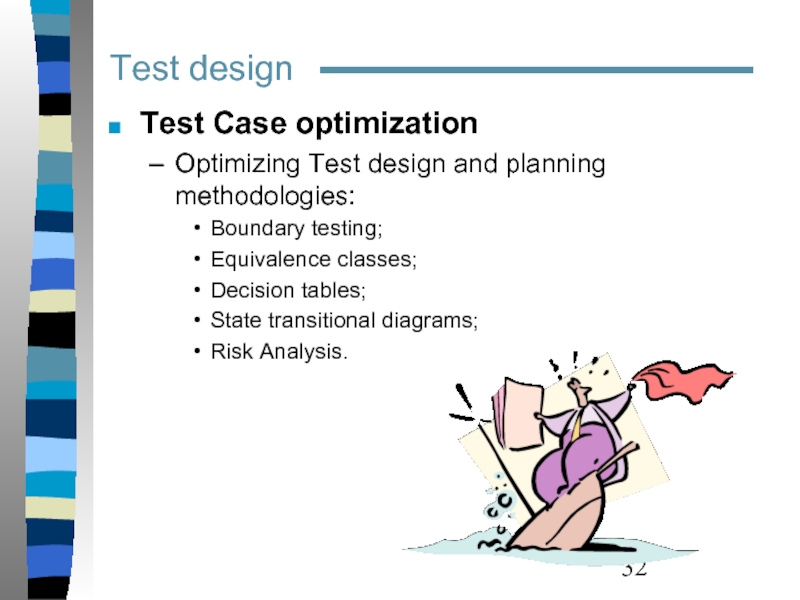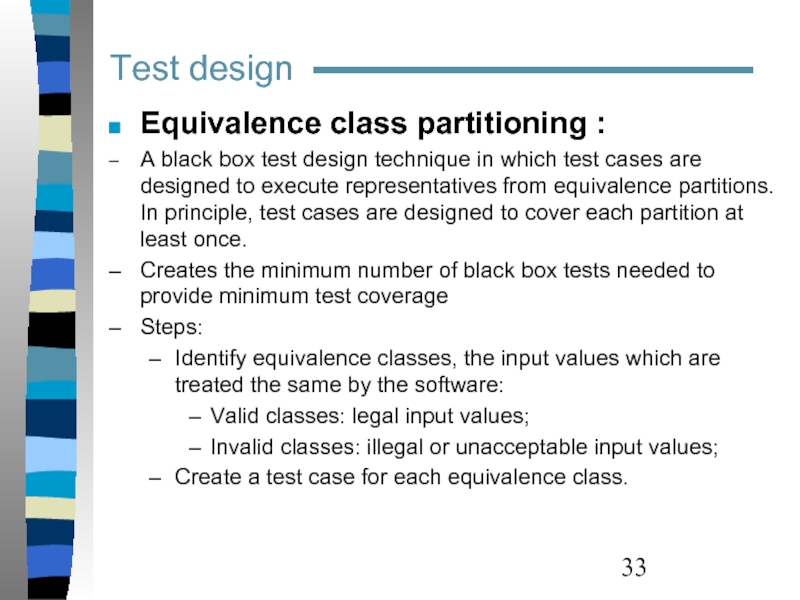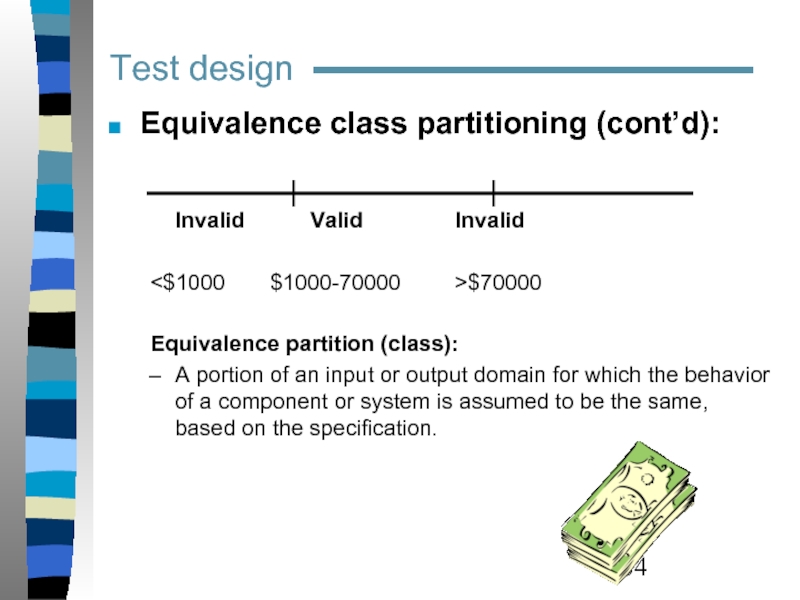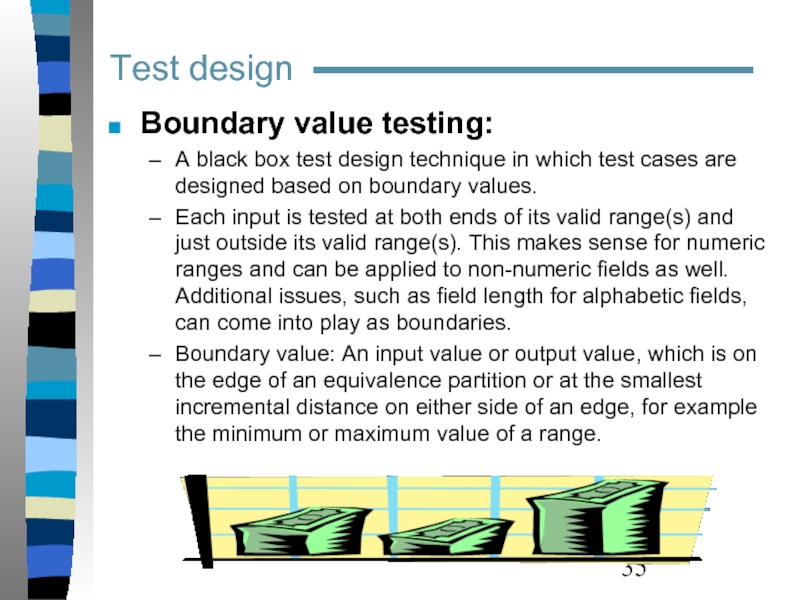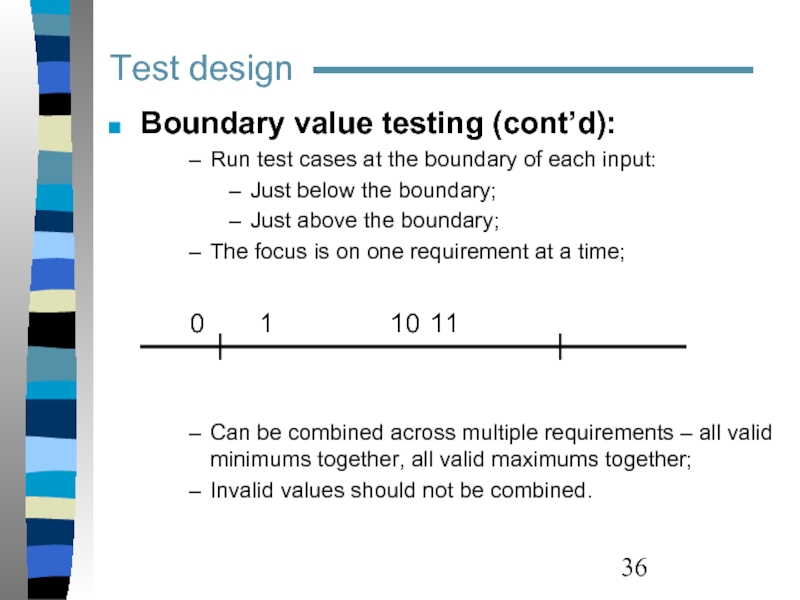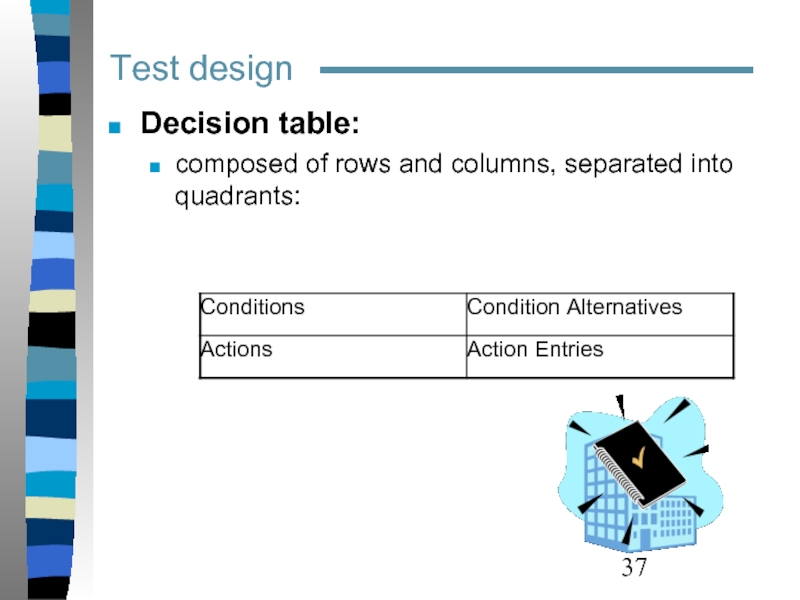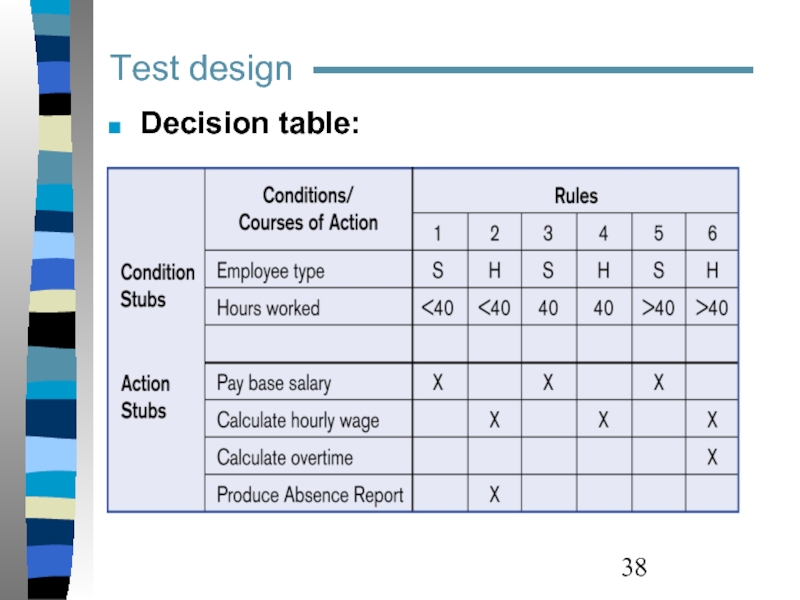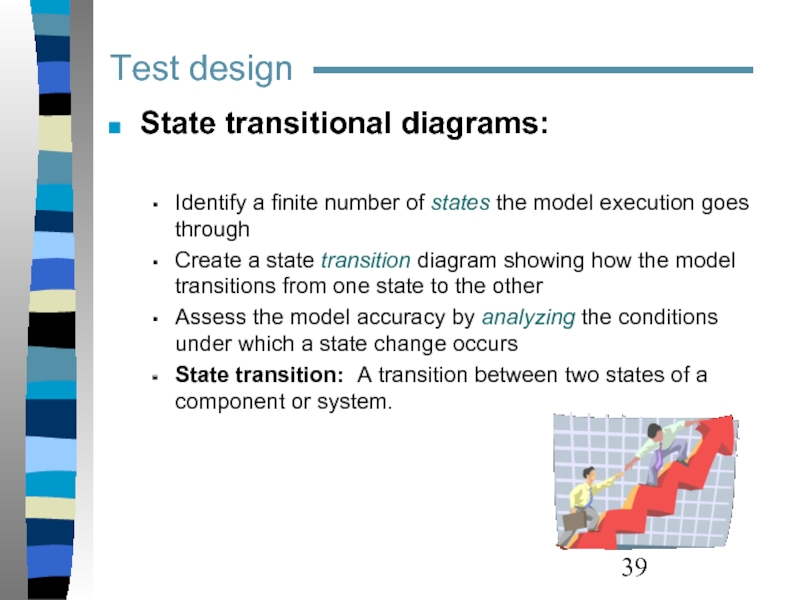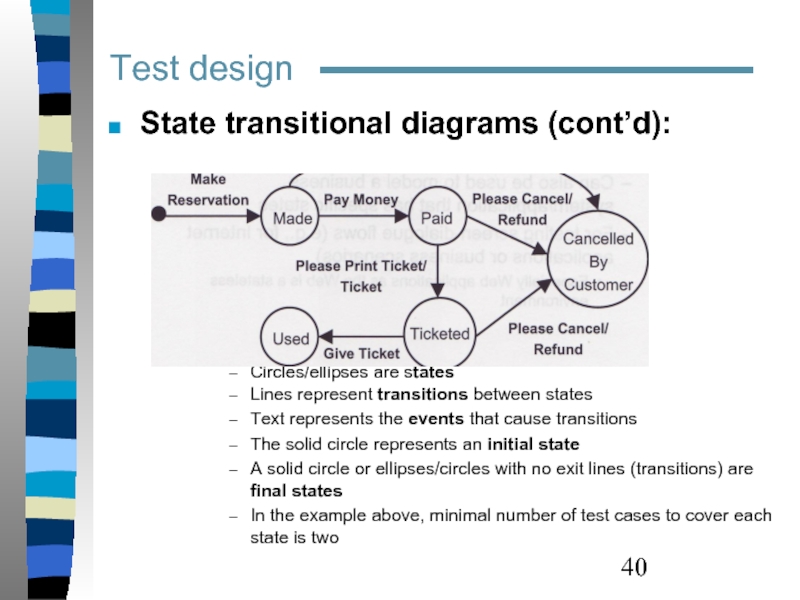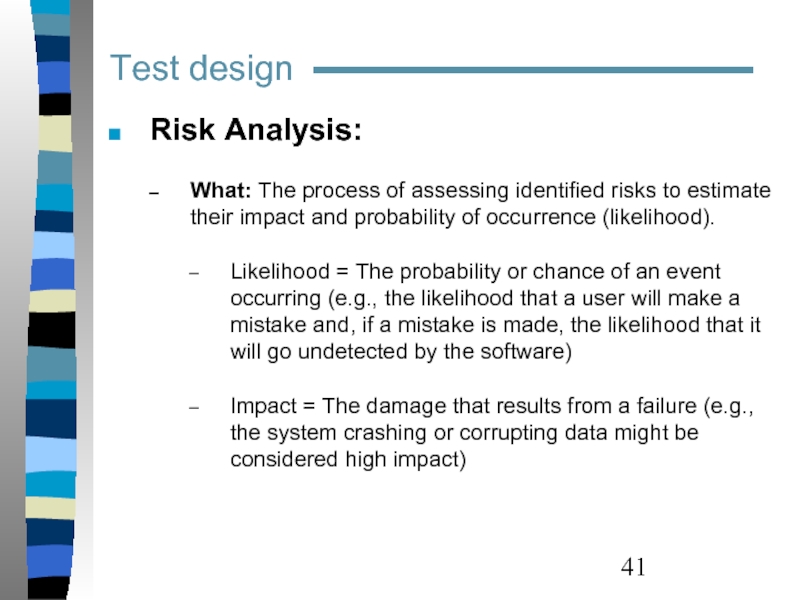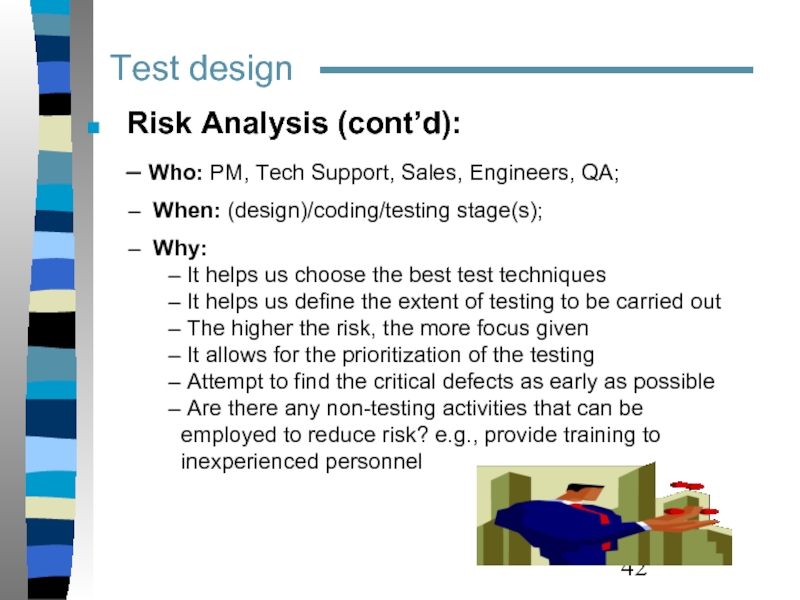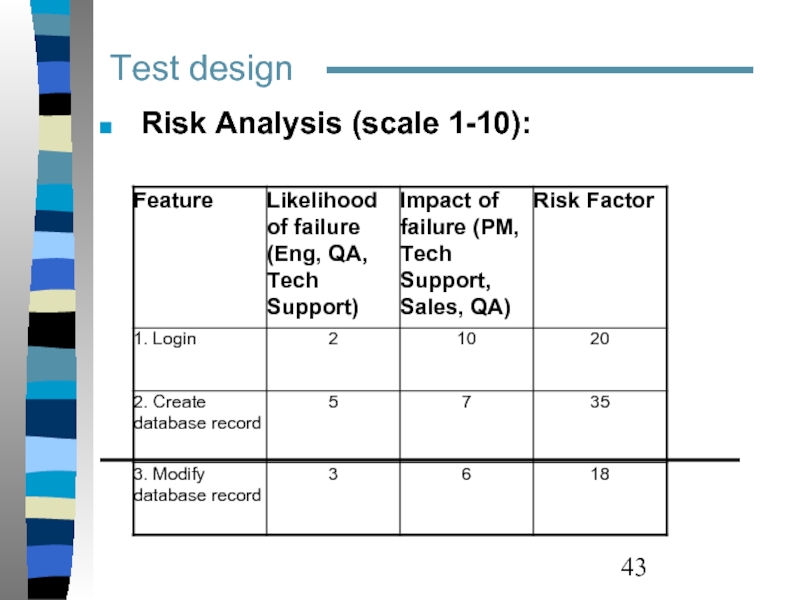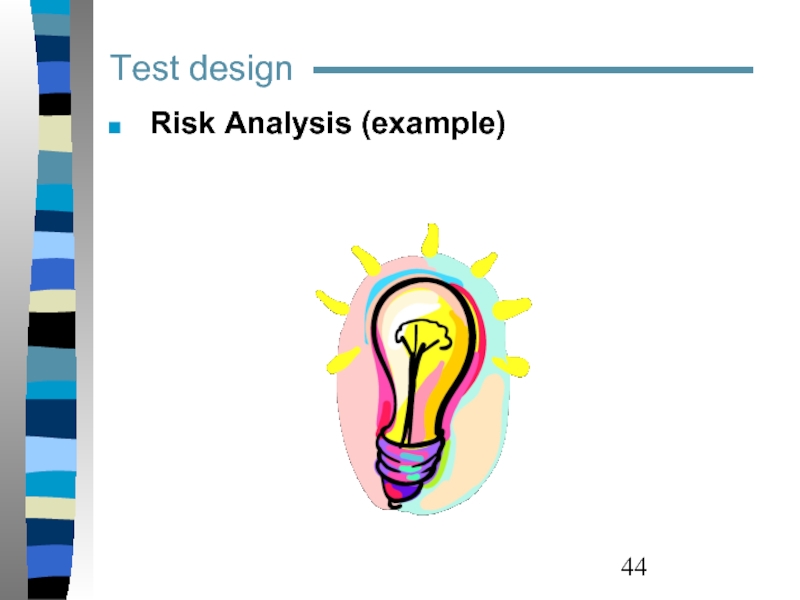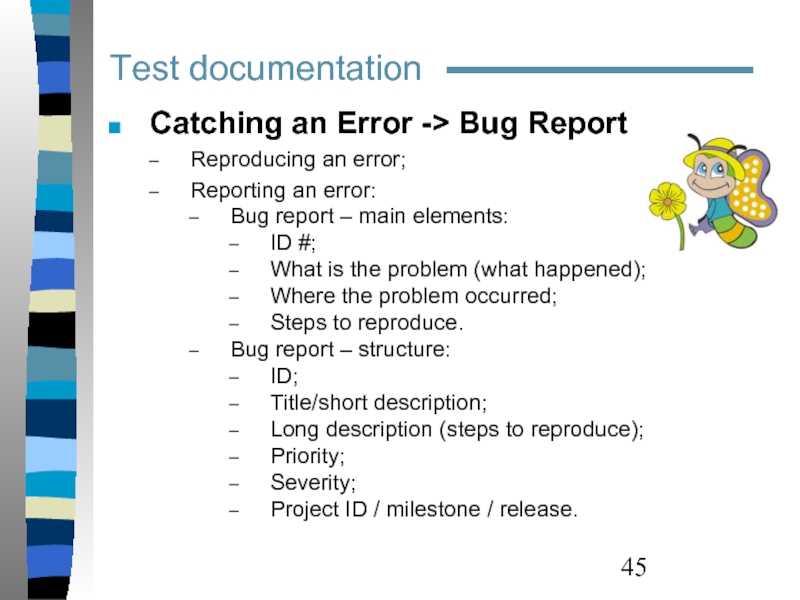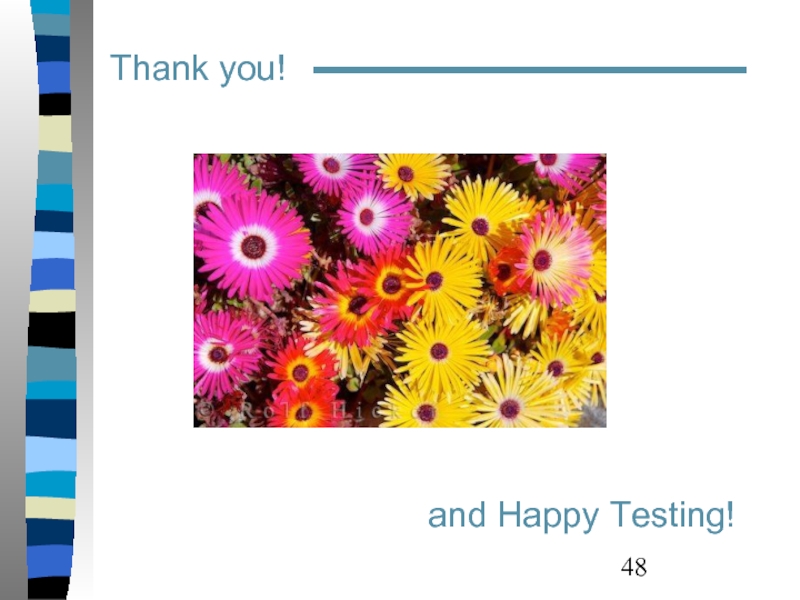- Главная
- Разное
- Дизайн
- Бизнес и предпринимательство
- Аналитика
- Образование
- Развлечения
- Красота и здоровье
- Финансы
- Государство
- Путешествия
- Спорт
- Недвижимость
- Армия
- Графика
- Культурология
- Еда и кулинария
- Лингвистика
- Английский язык
- Астрономия
- Алгебра
- Биология
- География
- Детские презентации
- Информатика
- История
- Литература
- Маркетинг
- Математика
- Медицина
- Менеджмент
- Музыка
- МХК
- Немецкий язык
- ОБЖ
- Обществознание
- Окружающий мир
- Педагогика
- Русский язык
- Технология
- Физика
- Философия
- Химия
- Шаблоны, картинки для презентаций
- Экология
- Экономика
- Юриспруденция
Test documentation and test case design презентация
Содержание
- 1. Test documentation and test case design
- 2. Testing in Software Development Testing
- 3. Software Development Software Development Life Cycle:
- 4. Software documentation PRD (Product Requirement Document) FS
- 5. PRD (Product Requirement Document) What: set of
- 6. Software documentation PRD (example)
- 7. FS (Functional Specification) What: software design document;
- 8. FS (example) Software documentation
- 9. Test Plan What: a document describing the
- 10. Test Plan (cont’d) Why: Divide responsibilities between
- 11. Test Plan (example) Test documentation
- 12. Test Case What: a set of inputs,
- 13. Test documentation Test Case (cont’d) Five
- 14. Test documentation Test Case (cont’d) Optional
- 15. Test documentation Test Case (cont’d)
- 16. Test documentation Test Case (cont’d) Format
- 17. Test documentation Test Case (exercise)
- 18. Test documentation Test Case (example)
- 19. Test documentation Test Suite A document
- 20. Traceability matrix What: document tracking each software
- 21. Traceability matrix (example) Test documentation
- 22. Test design Testing Levels Various
- 23. Test design Testing Levels Acceptance testing:
- 24. Test design Testing Strategies Depend
- 25. Test design Test Types There are
- 26. Test design Test Types (cont’d) Functional
- 27. Test design Test Types (cont’d) Non-Functional
- 28. Test design Test Types (cont’d) Structural
- 29. Test design Test Types (cont’d) Black
- 30. Test design Test Types (cont’d) Regression
- 31. Test design Static Test Techniques Static
- 32. Test design Test Case optimization Optimizing
- 33. Test design Equivalence class partitioning :
- 34. Test design Equivalence class partitioning (cont’d):
- 35. Test design Boundary value testing: A
- 36. Test design Boundary value testing (cont’d):
- 37. Test design Decision table: composed of
- 38. Test design Decision table:
- 39. Test design State transitional diagrams:
- 40. Test design State transitional diagrams (cont’d):
- 41. Test design Risk Analysis: What:
- 42. Risk Analysis (cont’d): Who:
- 43. Test design Risk Analysis (scale 1-10):
- 44. Test design Risk Analysis (example)
- 45. Test documentation Catching an Error ->
- 46. Q&A
- 47. Homework Chapters 7, 12
- 48. Thank you! and Happy Testing!
Слайд 2Testing in Software Development
Testing
= process of searching for software errors
How
Слайд 3Software Development
Software Development Life Cycle:
Planning
Design
Coding
Testing
Post-Release Maintenance
Слайд 4Software documentation
PRD (Product Requirement Document)
FS (Functional Specification)
UI Spec (User Interface Specification)
Test
Test Case
Test Suite
Traceability matrix
Risk Analysis matrix
Слайд 5PRD (Product Requirement Document)
What: set of software requirements
Who: Product Marketing, Sales,
When: planning stage
Why: we need to know what the product is supposed to do
QA role:
Participate in reviews
Analyze for completeness
Spot ambiguities
Highlight contradictions
Provide feedback on features/usability
Software documentation
Слайд 7FS (Functional Specification)
What: software design document;
Who: Engineering, Architects;
When: (planning)/design/(coding) stage(s);
Why: we
QA role:
Participate in reviews;
Analyze for completeness;
Spot ambiguities;
Highlight contradictions.
Software documentation
Слайд 9Test Plan
What: a document describing the scope, approach, resources and schedule
Who: QA;
When: (planning)/design/coding/testing stage(s);
Test documentation
Слайд 10Test Plan (cont’d)
Why:
Divide responsibilities between teams involved; if more than one
Plan for test resources / timelines ;
Plan for test coverage;
Plan for OS / DB / software deployment and configuration models coverage.
- QA role:
Create and maintain the document;
Analyze for completeness;
Have it reviewed and signed by Project Team leads/managers.
Test documentation
Слайд 12Test Case
What: a set of inputs, execution preconditions and expected outcomes
Who: QA;
When: (planning)/(design)/coding/testing stage(s);
Why:
Plan test effort / resources / timelines;
Plan / review test coverage;
Track test execution progress;
Track defects;
Track software quality criteria / quality metrics;
Unify Pass/Fail criteria across all testers;
Planned/systematic testing vs Ad-Hoc.
Test documentation
Слайд 13Test documentation
Test Case (cont’d)
Five required elements of a Test Case:
ID –
Features to be tested / steps / input values – what you need to do;
Expected result / output values – what you are supposed to get from application;
Actual result – what you really get from application;
Pass / Fail.
Слайд 14Test documentation
Test Case (cont’d)
Optional elements of a Test Case:
Title – verbal
Goal / objective – primary verification point of the test case;
Project / application ID / title – for TC classification / better tracking;
Functional area – for better TC tracking;
Bug numbers for Failed test cases – for better error / failure tracking (ISO 9000);
Positive / Negative class – for test execution planning;
Manual / Automatable / Automated parameter etc – for planning purposes;
Test Environment.
Слайд 15Test documentation
Test Case (cont’d)
Inputs:
Through the UI;
From interfacing systems or devices;
Files;
Databases;
State;
Environment.
Outputs:
To
To interfacing systems or devices;
Files;
Databases;
State;
Response time.
Слайд 16Test documentation
Test Case (cont’d)
Format – follow company standards; if no standards
MS Word document;
MS Excel document;
Memo-like paragraphs (MS Word, Notepad, Wordpad).
Classes:
Positive and Negative;
Functional, Non-Functional and UI;
Implicit verifications and explicit verifications;
Systematic testing and ad-hoc;
Слайд 19Test documentation
Test Suite
A document specifying a sequence of actions for the
Purpose: to put the test cases into an executable order, although individual test cases may have an internal set of steps or procedures;
Is typically manual, if automated, typically referred to as test script (though manual procedures can also be a type of script);
Multiple Test Suites need to be organized into some sequence – this defined the order in which the test cases or scripts are to be run, what timing considerations are, who should run them etc.
Слайд 20Traceability matrix
What: document tracking each software feature from PRD to FS
Who: Engineers, QA;
When: (design)/coding/testing stage(s);
Why: we need to make sure each requirement is covered in FS and Test cases;
QA role:
Analyze for completeness;
Make sure each feature is represented;
Highlight gaps.
Test documentation
Слайд 22Test design
Testing Levels
Various development models are there in the market
Within each
There are four basic levels of testing that are commonly used within various models:
Component (unit) testing
Integration testing
System testing
Acceptance testing
Слайд 23Test design
Testing Levels
Acceptance testing: Formal testing with respect to user needs,
System testing: The process of testing an integrated system to verify that it meets specified requirements.
Integration testing: Testing performed to expose defects in the interfaces and in the interactions between integrated components or systems.
Component testing: The testing of individual software components.
Слайд 24Test design
Testing Strategies
Depend on Development model.
Incremental: testing modules as they are
Requires additional code to be written, but allows to easily identify the source of error
Big Bang: testing is performed on fully integrated system, everything is tested with everything else.
No extra code needed, but errors are hard to find.
Слайд 25Test design
Test Types
There are several key types of tests that help
Functional testing: testing specific functions
Non-functional testing: testing characteristics of the software and system
Structural testing: testing the software structure or architecture
Re-testing (confirmation) and regression testing: testing related to changes
White and black box testing
Each test type focuses on a particular test objective
Test objective: A reason or purpose for designing and executing a test.
Test object: The component or system to be tested.
Test item: The individual element to be tested. There usually is one test object and many test items.
Слайд 26Test design
Test Types (cont’d)
Functional testing:
Testing based on an analysis of
The functions are "what" the system does:
They are typically defined or described in work products such as a requirements specification, use cases, or a functional specification;
They may be undocumented;
Functional tests are based on both explicit and implicit features and functions;
They may occur at all test levels, e.g., tests for components may be based on a component specification;
Functional testing focuses on the external behavior of the software (black-box testing).
Слайд 27Test design
Test Types (cont’d)
Non-Functional testing:
Focuses on "how" the system works;
Non-functional
These quantifications can vary and include items such as: response times, throughput, capacity for performance testing etc.
Testing the attributes of a component or system that do not relate to functionality, e.g. reliability, efficiency, usability, maintainability, compatibility and portability.
Слайд 28Test design
Test Types (cont’d)
Structural (White box) testing:
Testing based on an
May may be performed at all test levels - system, system integration, or acceptance levels (e.g., to business models or menu structures);
Structural techniques are best used after specification-based techniques;
Can assist in measuring the thoroughness of testing by assessing the degree of coverage of a structure;
Tools can be used to measure the code coverage.
Слайд 29Test design
Test Types (cont’d)
Black box testing:
The program is treated as
Inputs are fed into the program, outputs observed;
Search for interesting and challenging input combinations and conditions – they are most likely to expose an error.
Слайд 30Test design
Test Types (cont’d)
Regression testing (retesting):
Retesting of a previously tested
Tests should be designed to be repeatable – they are to be used for retesting; the more defects found, the more often the tests may have to run;
Full regression / Partial regression / No regression – the extent of regression is based on the risk of not funding defects;
Applies to functional, non-functional and structural testing;
Good candidate for automation.
Слайд 31Test design
Static Test Techniques
Static Testing:
Testing of a component or system
Non-execution based method for checking life cycle artifacts;
Manual static techniques: reviews (inspections, walkthroughs etc.), formal and informal;
Automated techniques: supporting reviews, static analysis tools (compilers);
Anything can be reviewed – PRD, Specs, Memos, Proposals, User Guides etc.
Слайд 32Test design
Test Case optimization
Optimizing Test design and planning methodologies:
Boundary testing;
Equivalence classes;
Decision
State transitional diagrams;
Risk Analysis.
Слайд 33Test design
Equivalence class partitioning :
A black box test design technique in
Creates the minimum number of black box tests needed to provide minimum test coverage
Steps:
Identify equivalence classes, the input values which are treated the same by the software:
Valid classes: legal input values;
Invalid classes: illegal or unacceptable input values;
Create a test case for each equivalence class.
Слайд 34Test design
Equivalence class partitioning (cont’d):
Invalid Valid Invalid
$70000
Equivalence
A portion of an input or output domain for which the behavior of a component or system is assumed to be the same, based on the specification.
Слайд 35Test design
Boundary value testing:
A black box test design technique in which
Each input is tested at both ends of its valid range(s) and just outside its valid range(s). This makes sense for numeric ranges and can be applied to non-numeric fields as well. Additional issues, such as field length for alphabetic fields, can come into play as boundaries.
Boundary value: An input value or output value, which is on the edge of an equivalence partition or at the smallest incremental distance on either side of an edge, for example the minimum or maximum value of a range.
Слайд 36Test design
Boundary value testing (cont’d):
Run test cases at the boundary of
Just below the boundary;
Just above the boundary;
The focus is on one requirement at a time;
0 1 10 11
Can be combined across multiple requirements – all valid minimums together, all valid maximums together;
Invalid values should not be combined.
Слайд 39Test design
State transitional diagrams:
Identify a finite number of states the model
Create a state transition diagram showing how the model transitions from one state to the other
Assess the model accuracy by analyzing the conditions under which a state change occurs
State transition: A transition between two states of a component or system.
Слайд 40Test design
State transitional diagrams (cont’d):
Circles/ellipses are states
Lines represent transitions between states
Text
The solid circle represents an initial state
A solid circle or ellipses/circles with no exit lines (transitions) are final states
In the example above, minimal number of test cases to cover each state is two
Слайд 41Test design
Risk Analysis:
What: The process of assessing identified risks to estimate
Likelihood = The probability or chance of an event occurring (e.g., the likelihood that a user will make a mistake and, if a mistake is made, the likelihood that it will go undetected by the software)
Impact = The damage that results from a failure (e.g., the system crashing or corrupting data might be considered high impact)
Слайд 42 Risk Analysis (cont’d):
Who: PM, Tech Support, Sales, Engineers,
When: (design)/coding/testing stage(s);
Why:
It helps us choose the best test techniques
It helps us define the extent of testing to be carried out
The higher the risk, the more focus given
It allows for the prioritization of the testing
Attempt to find the critical defects as early as possible
Are there any non-testing activities that can be employed to reduce risk? e.g., provide training to inexperienced personnel
Test design
Слайд 45Test documentation
Catching an Error -> Bug Report
Reproducing an error;
Reporting an error:
Bug
ID #;
What is the problem (what happened);
Where the problem occurred;
Steps to reproduce.
Bug report – structure:
ID;
Title/short description;
Long description (steps to reproduce);
Priority;
Severity;
Project ID / milestone / release.
